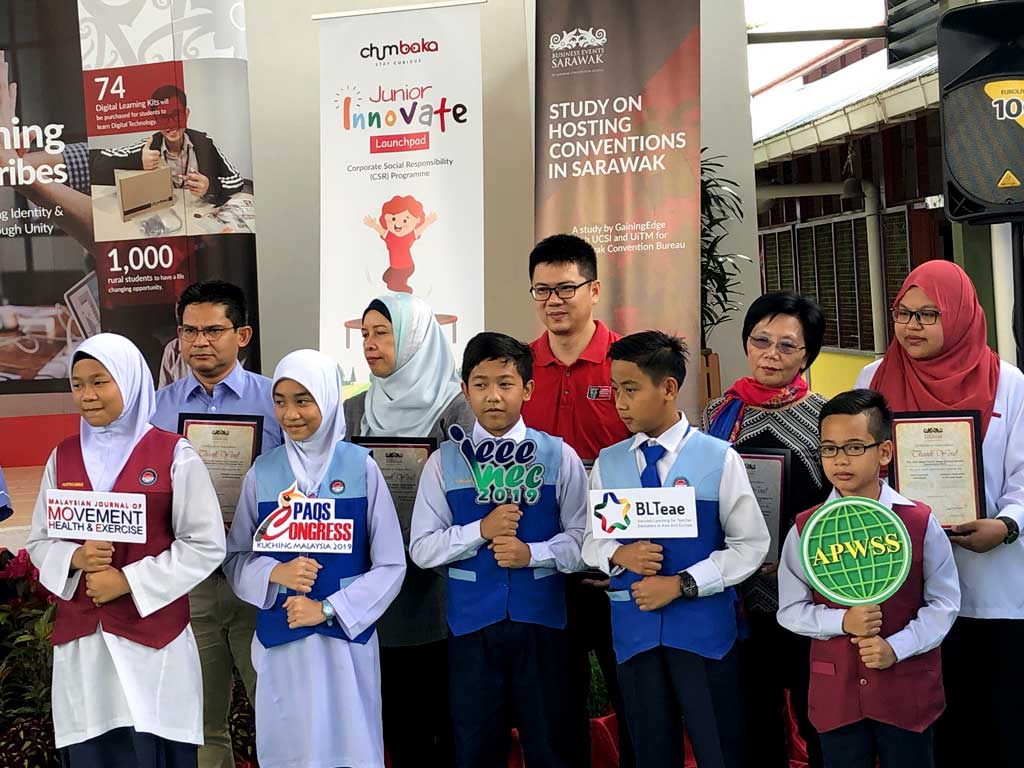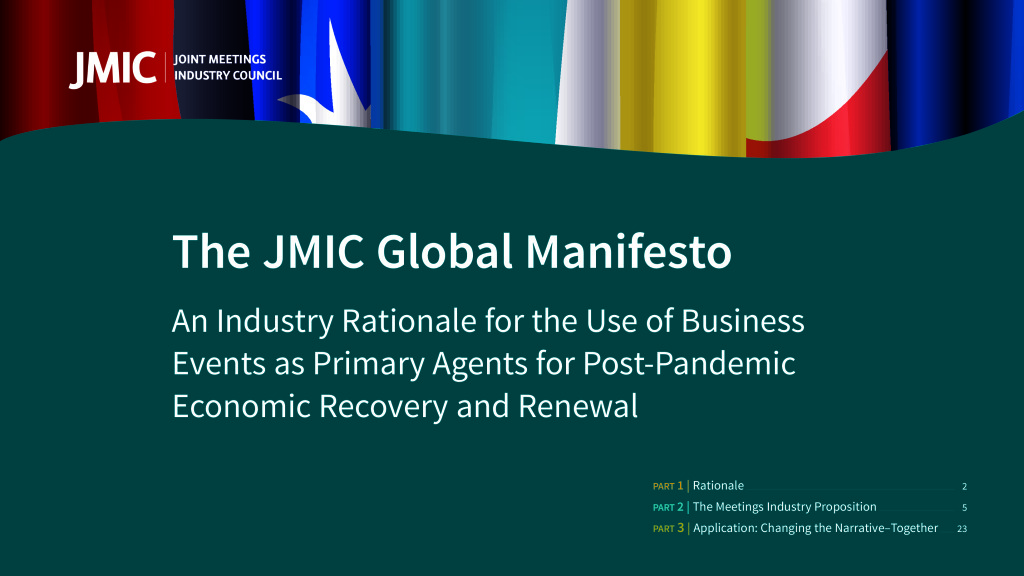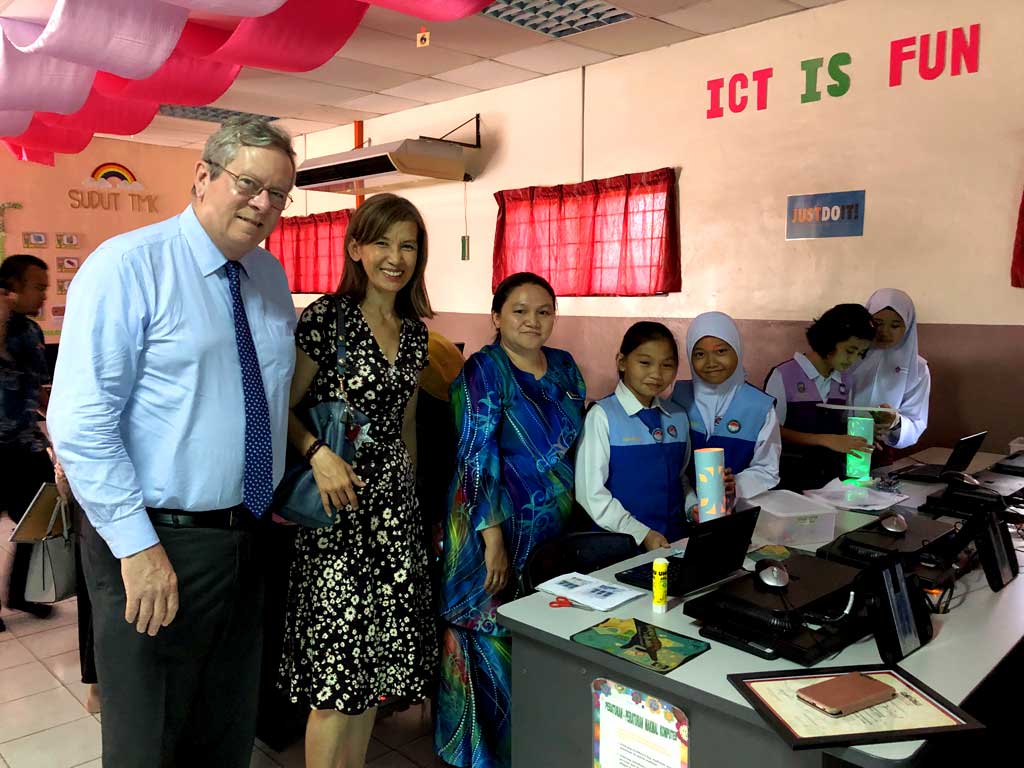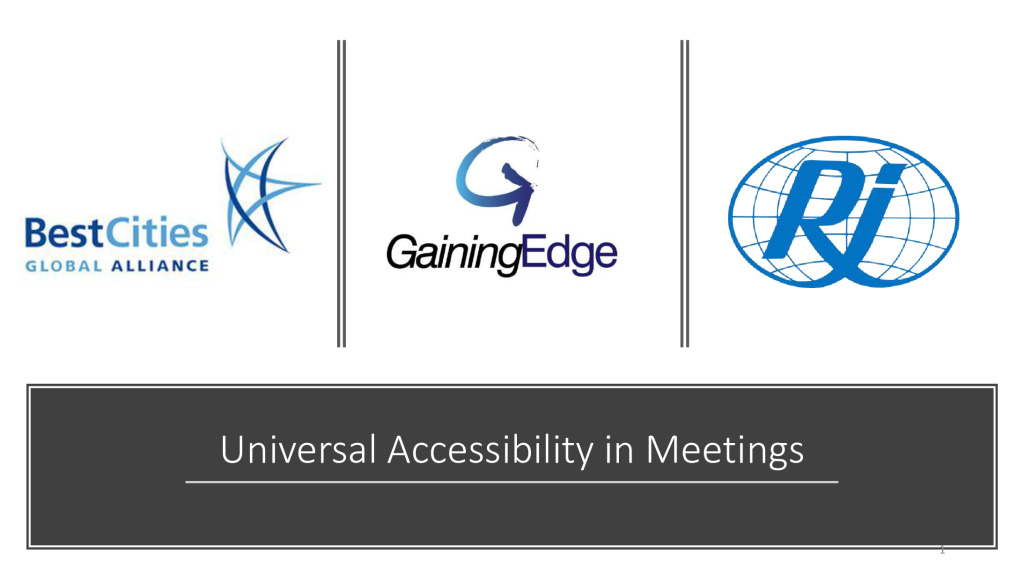PRESS RELEASE GainingEdge, a global leader specializing in providing advice to the business events industry, is pleased to be offering its first round of instructor-led, online courses as of May 10th. These 90-minute courses will provide industry professionals an opportunity to upskill their expertise through practical and interactive learning sessions. Led by senior GainingEdge specialists,… Continue reading GainingEdge Launches Online Training
Industry Solution: Convention & Exhibition Centre Advisory
Tracking the MICE Sector’s Return in a COVID-19 World: Part 2
22 September 2020
Which destinations are open and how are they handling the return of the MICE sector faced with risks of second waves of infections and lockdowns? Less than 10 destinations with effective suppression are fully open for large scale events without capacity limits. But others are lining up.
Reliant on travel and large gatherings, the MICE sector is considered high-risk during the pandemic and remains mostly shut. 41 EU countries have open borders for travel, yet events are restricted.
Covid-19 continues to intensify in many emerging and developing economies. Borders in over 100 destinations including Canada, Australia and India remain completely closed to visitors.
A consensus is emerging that even with our optimism for a vaccine we will not be Covid-free before 2022. We face a long transition phase that is uncertain and volatile before we reach the New Normal. The pace of recovery will vary across regions and segments.
Which destinations are open for MICE events?
It is estimated that over 40 countries are open for events but most have capacity limits and other restrictions.
Country
China
Taiwan
Hong Kong
Korea
New Zealand
Malaysia
Thailand
Japan
Netherlands
Germany
United Kingdom
Singapore
UAE
From
May
May
May
May
May
June
June
June
July
September
October
October
October
Capacity
no size limit
no size limit
no size limit
no size limit
no size limit
up to 250 people
no size limit but maximum 20,000 sqm
up to 5,000 people
limit subject to social distancing capacity
limit subject to social distancing capacity
limit subject to social distancing capacity
up to 250 people
limit subject to social distancing capacity
What does MICE activity look like in the open destinations?
Destinations that are widely open are those that have Covid under control. Even then, they face the risks of second waves of infections and re-imposition of lockdowns.
China and South Korea returned by hosting major domestic construction and automotive expos of 62,000 and 45,000 visitors respectively in May.
First in, first out of Covid, China, supported by the world’s largest domestic market is clearly leading the return of the MICE sector in terms of level of activity. Shenzhen World alone has hosted numerous events with total visitors through its door since Covid reaching 1 million.
Supported by large domestic catchments, consumer expos are leading the return. Trade expos and Government meetings are also showing good form. Local corporate meetings and conventions are only just gaining confidence. Confidence for international conventions is unlikely until vaccination, treatment or effective suppression is achieved. Open borders alone will not restore confidence for the cautious international consumer.
Some of the high profile expos on reopening include:
- The 2020 Hunan Auto Show, 20 April – 5 May with 62,000 visitors, daily cap 8,000 – Hunan International Convention and Exhibition Center, China
- MBC Construction Expo, 8-11 May with 45,000 visitors – KINTEX, Korea
- The 98th Hong Kong Wedding Fair May 22-24, 400 booths and daily cap of 3,000 visitors – Hong Kong Convention & Exhibition Centre, Hong Kong
- Taipei International Graphic Arts Exhibition, 30 July – 3 August with 80,000 visitors – Taipei World Trade Center, Taiwan
Germany has led Europe’s return of large scale events with the Caravan Salon Expo held 5-13 September at Messe Dusseldorf attracting 107,000 visitors with a daily cap of 20,000. This is seen as the first large scale expo with international (EU) attendance.
2020 SEMICON Taiwan scheduled for September is the first comprehensive hybrid trade show with international participants.
Venues in these markets are writing the playbook for hosting in-person events in a pandemic with extensive new protocols like pre-registration, temperature checks, face masks, gloves, elevated hygiene, social distancing, and density monitoring.
Virtual and hybrid events are filling some of the void. It is difficult to determine how much demand for virtual events is driven by the free access, try-out, lack of physical options, and downtime. Drop out rates on virtual events are high, but surely the consumer behavior being acquired will help rapid improvement of digital platforms.
China’s Canton Fair in June was the first large scale expo held entirely on a virtual platform, supported by Tencent. It attracted 25,000 virtual exhibitors but closed with mixed reviews.
Virtual platforms have an enviable window to enhance their offer as a serious commercial option if it is to retain a fair share of the gains made during this covid-normal phase.
ABOUT THE AUTHOR ROD KAMLESHWARAN

Rod leads the Convention and Exhibition Centre Development advisory team at GainingEdge. His expertise is in the development and asset management of hospitality assets – convention & exhibition centres, hotels, and casino integrated resorts. A specialist in mixed-use developments, Rod has advised government and private sector clients on projects with a completion value exceeding US$20 billion. Rod was previously at PwC and IHG.
For more articles/news, please visit News & Resources.
We take a look at the impact of COVID-19 pandemic on the business events sector. A consensus is emerging that even with our optimism for a vaccine, we will not be COVID-19 free before 2022. Read Rod Kamleshwaran’s take on the return of the MICE sector in a world that is faced with risks of second waves of infections and lockdowns.
The MICE Sector in a Covid-19 World: Lockdown, Transition, New Normal
7 August 2020
On 30 July, UNWTO reported that 40% of destinations have eased travel restrictions. On the same day, WHO issued guidelines for resuming travel saying travel bans due to Covid-19 cannot be indefinite.
We are now in a Transition Phase where economic activity is resuming in a world inclusive of Covid-19. This phase will last until widespread vaccination, probably not before 2022, when the New Normal without the virus begins.
IATA, July 2020 reports that passenger numbers in 2020 will drop by 55%, to 2006 levels, and may not recover to 2019 levels until 2024.
STR, June 2020 predicts that USA hotel revenue per available room (RevPAR) is unlikely to return to 2019 levels before 2023.
Air traffic and hotel demand are broad indicators for the meetings, incentives, conventions, and exhibitions (MICE) sector. Recovery of the MICE sector seems unlikely to take less than 5 years.
The pace and level of recovery will vary by region and business segment. Domestic markets will return before international, and leisure segments will precede business segments. As the crisis is unprecedented and still evolving, the full recovery period remains uncertain.

The “Lockdown Period”
The relates primarily to March through May after the Covid-19 pandemic was announced spurring a global lockdown. This led to the closure of borders and most economic activity. In many countries, non-essential activities ceased for up to 4 months. Many imposed curfews.
Past crises were confined to smaller segments of the world. Not this time. On 6 April 2020, WHO reported that 96% of all worldwide destinations had introduced travel restrictions. IATA reported a 94% drop in air traffic for April 2020.
Many emerging and developing economies remain in lockdown as Covid-19 intensifies.
The “Transition Phase”
Most countries are now in this second phase. The reopening is not just of countries that have suppressed Covid-19 but also those with high active cases and so with the risks of second waves of infections and re-imposition of lockdowns.
June marked widescale relaxations in restrictions allowing domestic market activity in many countries. In the same month, some destinations began opening up to regional markets.
In July, UNWTO reported that 40% of destinations easing travel restrictions, up from 22% in June. Of the 87 countries to ease travel restrictions, four completely lifted all travel restrictions – Albania, Maldives, Serbia and Tanzania.
115 destinations including Australia, Canada and India continue to keep their borders completely closed.
The gradual opening is largely attributed to the Northern Hemisphere summer season led by the opening of borders in the European Union on 1 July. Europe leads the opening with 41 nations, 20 in the Americas, 13 in Africa, 10 in Asia-Pacific, and 3 in the Middle East.
China and USA – countries with strong domestic bases are leading the recovery pack with weekly occupancies of up to 55% and 48% respectively in late July. STR is reporting other regions at barely much more than 20%. USA hotels tend to rely more on MICE business than in the Asia Pacific where the leisure market is more dominant. Without this group business, the USA hotel recovery will plateau.
If the 87 countries manage this large-scale travel without a significant rise in cases, it will go a long way towards creating the consumer confidence needed for a genuine recovery. Conversely, a spike in cases risks a major setback.
Hotel recovery is led by non-luxury categories with domestic leisure peaking on weekends. Corporate travel recovery has begun in some markets, but many small meetings will not return from the virtual platforms adopted during the lockdown.
MICE sector recovery is led by domestic events. Protocols include contactless registration, thermal scanning, face masks, elevated hygiene and social distancing. Social distancing is easier to handle with exhibitions than conferences. Countries like China, Korea, Taiwan and Germany are leading the return of large-scale events with exhibitions and government events.
Many events have turned to virtual or hybrid formats in the short term. The importance of digitisation and flexibility of venues has escalated. Multi-location events where in-person events in different regional locations connect online to form a larger global event are growing. This is appealing in the current phase as attendees lack confidence for travel and large gatherings.
The “New Normal”
This has been described as a once-in-a-century pandemic. It has challenged us to completely re-evaluate how we think, live and work.
The 9/11 terror attacks led to dramatic changes in attitudes to safety, security and privacy. Covid-19 is having a dramatic impact on geopolitics, technology and social attitudes. Technology has proven fundamental to coping with this disruption. Driven to better prepare for the next pandemic or biosecurity threat, organisations will seek to strengthen agility and resilience.
It has long been accepted that there is a strong relationship between the unemployment rate and hotel demand. Hence, at some point, consumer behaviour will be dependent on economic, not health factors. After borders are wide open and consumer confidence in safe travel has returned, economics will influence hotel demand.
There will be significant shifts in the MICE industry in the post Covid-19 era. Some will be structural and permanent. Some will be temporary. Some are already in place.
Once the viral threat has faded, the attention on hygiene and social distancing may also fade.
In-person interaction remains powerful and unlikely to be replaced by virtual events in a dominant way. In-person events are attractive for commercial and networking purposes. Most events will return as in-person events, but a high portion will be hybrid events.
Covid-19 will accelerate digital trends. Consumer exhibitions will embrace virtual event formats more readily than trade exhibitions. Corporates will in future distinguish between essential and non-essential travel. Some meetings, especially internal meetings, will not fully return to pre Covid-19 levels.
Venue offers will include in-person, hybrid or virtual options with enhanced technology infrastructure and flexible rooms. Virtual tours for venues will be the norm. Virtual meeting and event software will improve at a rapid pace. Contactless operations beyond check-in is here to stay.
New certifications, accreditations and quality standards on hygiene will be normal.
Solutions for crowd monitoring, electrostatic sprayers to disinfect surfaces in function rooms and public spaces, automated self-cleaning machines for escalators, and enhanced air filtration systems for ventilation will be promoted as safety features at many venues.
Venues will need to assess both “hardware” and “software” readiness for this New Normal.
When this New Normal without Covid-19 begins is unclear. Even after a vaccine is found, it may take a year or more before widespread vaccination and the confidence for mass travel returns. A consensus is emerging that the virus will stay for a while and the world has to figure out how to live with it.
We shouldn’t let our high hopes for a vaccine deter us from finding solutions that let us live as close to normal as possible now, even in a highly disrupted world with Covid-19. But we must also be cognisant of the risks of second waves of infections and re-imposition of lockdowns.
ABOUT THE AUTHOR ROD KAMLESHWARAN

Rod leads the Convention and Exhibition Centre Development advisory team at GainingEdge. His expertise is in the development and asset management of hospitality assets – convention & exhibition centres, hotels, and casino integrated resorts. A specialist in mixed-use developments, Rod has advised government and private sector clients on projects with a completion value exceeding US$20 billion. Rod was previously at PwC and IHG.
For more articles/news, please visit News & Resources.
We are now in a Transition Phase where economic activity is resuming in a world inclusive of Covid-19. This phase will last until widespread vaccination, probably not before 2022, when the New Normal without the virus begins.
Tracking the Return of the MICE Events Sector in a Covid-19 World
After months of lockdown, many countries are now seeing a gradual re-opening of its events sector. This is not limited to just countries that have suppressed Covid-19, but also many where the situation remains uncertain as they face a second wave of cases.
There is a consensus emerging that Covid-19 is here to stay and the world has to figure out how to live with it, at least until a vaccine is found. This may be months or even years. So, the new norm is a world with Covid-19 until we transition to a stable Post Covid-19 world probably not before 2022.
For most countries re-opening this sector, the focus is on domestic conference and exhibition events. However, some destinations in Europe as well as the Caribbean, China, Taiwan and UAE have progressed to events with international attendees from approved countries.
China, Taiwan, Hong Kong, Singapore, South Korea, Japan, Thailand, Malaysia, Australia, New Zealand, Germany, Greece, Spain, Italy, UK, Switzerland and Norway are just some of the countries that have opened up their venues or announced imminent opening.
So how do events look like in the Covid-19 World? Images from New Zealand and Taiwan of full capacity stadiums and exhibitions halls may suggest it doesn’t look much different to Pre Covid-19. These countries have ostensibly eliminated Covid-19 and have opened up their domestic markets with almost no restrictions. However, for most other countries still battling Covid-19, venues are opening with new protocols such as thermal temperature screening, face masks, frequent disinfection of high use areas, and social distancing in high concentration areas of the building.
Even with the regulatory barriers on the opening of venues and borders removed, the recovery is going to be dependent on consumers and businesses having confidence that destinations and venues are safe to visit.
Events organised by Government agencies (e.g. trade shows) are often leading the reopening in efforts to create confidence. As the first region to encounter COVID-19, Asia is also now leading the re-opening of economies and venues.
Surveys are finding optimism growing among destinations. Optimism for both business and leisure travel continues to increase, with about 40% of those studied in a recent US survey, expecting to travel during the next six months (McKinsey & Company).
In this Covid-19 World, MICE events will behave differently to the past. Whilst recovery will differ country by country, we can expect common themes. There will be a higher focus on smaller domestic events with elevated hygiene and social distancing demands and a higher level of virtual or hybrid events. Social distancing, when required, is easier to handle with exhibitions than conferences. This suggests more exhibitions before conferences. It is expected that younger people will travel first. Travel will involve nearby destinations.
Digitisation and flexibility of venues will be highly important. Covid-19 will significantly accelerate digital trends. Venues will be expected to offer the option for virtual and hybrid events with enhanced technology infrastructure and flexible rooms. In this transition phase, some events may go fully virtual while others go hybrid.
Hybrid events include the main event with in-person attendance complemented by additional virtual attendees and speakers. Future options may include multi-location events that are a collection of in-person events in different cities joining online to form a larger global event. This would allow in-person attendance in a local or regional destination avoiding large scale gatherings. This may be appealing in the current phase as attendees lack confidence for travel and large gatherings.
In-person interaction remains powerful and unlikely to be dominantly replaced by virtual events anytime soon. In-person events are attractive for commercial and networking reasons. It is more plausible that in the stable Post Covid-19 World most events return as in-person events with a significant proportion as hybrid events. Indeed, some events, especially small meetings may be candidates for permanent virtual only events.
Venues located in safe destinations, offering modern flexible spaces and advanced technology are likely to be more attractive for large scale international events.
Other trends may include:
- New certifications, accreditations and quality standards on hygiene
- Virtual tours or site inspections for venues
- Thermal scanning temperature checks and other testing
- Contactless registration and staggered registration to prevent overcrowding
- Flexible room and seating configurations to support social distancing when required
- Crowd monitoring and control at high-density areas within venues
- Electrostatic sprayers to disinfect surfaces in function rooms and public spaces
- Automated self-cleaning machines for escalators
- Sanitising furniture and equipment after each use
- Enhanced air filtration systems for ventilation in venues
- Policies for isolation and contact tracing following positive Covid-19 tests
- Social distancing and protective equipment
- Preference for ala carte and boxed lunches instead of buffets
- Adverse impact on sponsorships but some mitigation as the acceleration of digital solutions create new sponsorship opportunities
- Competing issues in contract language as organisers seek flexible cancellation terms whilst venues seek stricter terms to protect their own exposure
- Increased focus on contingency planning and crisis management plans
Like other economic sectors, the MICE sector is also adjusting to a new evolving playbook. Government agencies, as well as industry associations and venues, have been busy announcing guidelines for hosting MICE events in a Covid-19 World. Two examples of such guidelines include Good Practice Guide: Addressing COVID-19 Requirements for Re-Opening Business Events and Global Protocols for the New Normal Convention Centre.
MICE – Meetings, Incentives, Conferences, Exhibitions also know as Business Events
ABOUT THE AUTHOR ROD KAMLESHWARAN

Rod leads the Convention and Exhibition Centre Development advisory team at GainingEdge. His expertise is in the development and asset management of hospitality assets – convention & exhibition centres, hotels, and casino integrated resorts. A specialist in mixed-use developments, Rod has advised government and private sector clients on projects with a completion value exceeding US$20 billion. Rod was previously at PwC and IHG.
For more articles/news, please visit News & Resources.
After months of lockdown, many countries are now seeing a gradual re-opening of its events sector.
The JMIC Global Manifesto
An Industry Rationale for the Use of Business Events as Primary Agents for Post Pandemic Economic Recovery and Renewal The Joint Meetings Industry Council has released a meetings Industry Manifesto, which makes the case for why conventions, trade shows and other business events are key to driving a global economic recovery. This manifesto is developed as a resource… Continue reading The JMIC Global Manifesto
Walking the Talk: The ICT CSR Legacies of Sarawak CB
Source: The Iceberg, posted on 24 April 2019
School computer labs across rural Sarawak, Malaysia, will be benefitting after convention organisers and their delegates complete surveys from the Sarawak Convention Bureau. Sarawak CB will be making a donation for each returned form to the Chumbaka Junior Innovate Fund.
Many of the world’s corporate citizens and organisations incorporate an element of Corporate Social Responsibility (CSR) into their event programmes as their giving-back to society. Besides building a positive business reputation, better brand recognition (and increased sales), such programmes also help enhance their team members’ loyalty while cementing interpersonal bonds.
In my last story, I shared how two organisations – the International Congress and Convention Association (ICCA) and the Tourism Promotion Board Philippines – used meetings and conventions as their conduit to CSR. I was recently delighted to be part of similar efforts closer to home.
The Sarawak Convention Bureau (Sarawak CB, also known as Business Events Sarawak) has hit on an effective and meaningful way to build CSR into ten national and international conventions that will take place in the Malaysian state this year. As part of a research project which covers these ten conventions, the participants, local host committees and also the HQ organisations (where applicable) will be surveyed.
For every completed questionnaire, Sarawak CB will donate $1.00 to the Chumbaka Junior Innovate Fund. This Fund is a home-grown effort targeted at rural schools in Sarawak with the goal of introducing these students to the world of digital technology. It is hoped that by the end of the campaign, enough funds would have been raised to purchase some 70 digital learning kits for these schools.
The Chairman of Sarawak CB, Tan Sri Dato Sri Dr Muhammad Leo Toyad Abdullah said: “We want to emphasize the importance of business events as the driver that accelerates change in Sarawak. Our latest initiative will power the children of today, for tomorrow.”
Echoing his sentiments, Sarawak’s Minister of Education, Science and Technological Research Dato Sri Michael Manyin Jawong, who was also present at the Launch of the Chumbaka Innovate Fund in a school just outside Kuching, reiterated that his Ministry will continue to actively pursue the impacts from this legacy so that Sarawak can be a role model leader in education and research.

Photo: Local hosts of the conventions with students during the Chumbaka Junior Innovate Fund launch.
The ten selected conventions for this CSR project are 8th International Conference on Bioprocessing; Conference on Inclusive Early Childhood Education; 1st World Chinese Medicine Forum; 24th International Kodaly International Symposium; 3rd MSHA International Spinal Health Congress; 6th Movement, Health and Exercise Conference and 12th International Sports Science Conference; Congress of the Pacific Association of Quantity Surveyors; IEEE Nanoelectronics Conference; 1st International Conference on Education in the Digital Ecosystem; and the 27th Asian-Pacific Weed Science Society Conference.
Sarawak CB is no stranger to investing time and effort on legacy outcomes – when the bureau played host to the 2016 ICCA Annual Congress in Kuching, a CSR project linked to the state’s endangered primate – the orangutan or Man of the Forest – kicked off with their pre-event marketing. Additionally, when ICCA Congress participants converged in Kuching, they were encouraged to bring one or two English language books with them for the Book Share Programme, an initiative of the Librarians Association of Malaysia – Sarawak Chapter. These books, donated by ICCA members from around the world, eventually made their way to libraries and community halls in rural Sarawak.
It is indeed heartening that the state has put such focus on its future generation. Be it mastering the English language or developing life skills in this age of digital technology, the government of Sarawak – through Sarawak CB – has skillfully used meetings and conventions to leave a legacy for its local communities. As they say in the Malay language in Sarawak, “terima kasih” – “thank you” – to all convention participants and host organisations who are helping in this endeavor.
Jane Vong Holmes, Senior Manager Asia, GainingEdge

Jane Vong Holmes is senior manager – Asia of GainingEdge, a consultancy specialising in the business events industry. She has co-authored two UNWTO publications on the Asian meetings industry and various destination market studies. She is an ardent advocate for giving back to communities through conventions and events. Most recently, she recently released a joint-report on universal accessibility in the meetings industry.
Many of the world’s corporate citizens and organisations incorporate an element of Corporate Social Responsibility (CSR) into their event programmes as their giving-back to society. Besides building a positive business reputation, better brand recognition (and increased sales), such programmes also help enhance their team members’ loyalty while cementing interpersonal bonds.
Perspectives: You Can Make a Difference Too
Source: TTG Asia, posted 9 January 2019
Businesses and associations are increasingly incorporating a corporate social responsibility (CSR) element in their meetings and events programmes.
One of my favourite examples is by the International Congress and Convention Association (ICCA), which has for years substituted speakers’ gifts at its annual congress and General Assembly with a financial donation to a charitable organisation selected by the Local Host Committee.
At its last two congresses in Prague and Dubai, a Fun Walk N Run was also organised for delegates who wanted to explore the city in a quick and fun way while taking the opportunity to offer a small financial donation to a local NGO. It was a great way to connect with other like-minded ICCA delegates and to start the day on an energetic note.
It is amazing how fast friendships can form this way.
Simultaneously, a grassroots project, ICCA Members Gift of Love (ICCA Members GOL), encourages delegates to bring a small gift with them to the congress. Since 2013, ICCA delegates have contributed wheelchairs, books, puzzles, children’s shoes, toys and spectacle frames to various NGOs around the world.
Past ICCA Members GOL partners include Local Host Committees and their selected charities – the Shanghai International Communication Center for The Disabled, China (2013); Losev Foundation for Children with Leukemia, Turkey (2014); Haciendo Camino, Argentina (2015); Malaysian Librarians Association Sarawak Chapter, Malaysia (2016); SOS Children’s Village, Czech Republic (2017); and Noor Dubai Foundation, the UAE (2018).
While everyone enjoys receiving gifts, even more people enjoy giving. I have seen how enthusiastically and carefully my fellow ICCA delegates have selected their gifts. Co-workers, mothers and neighbours have been recruited to expand the gift collection network as much as last-minute purchases at airports; with some even lovingly packed with a gift card and the warmest wishes.
Recently I participated in MICECON 2018, organised by the Tourism Promotions Board Philippines (TPB) in the city of Bacolod. Participants at this biennial national conference on business events – the sixth edition in 2018 – were encouraged to bring with them a small essential item in their suitcase. It could be a towel, blanket, children’s book or notebook with pen. These items were for the Holy Infant Nursery Foundation and the Bacolod Girls’ Home Foundation.
In addition, TPB worked with city officials – mayor Evelio “Bing” Leonardia and his team – and two food manufacturers which produce Bacolod’s famous delicacy, piaya (an unleavened flatbread). Tapping into the Philippines’ pasalubong culture or the practice of bringing home a food gift, the two food manufacturers Merczi and BongBong’s offered a percentage of their sales to the above-mentioned charities when any MICECON delegate produced his/her badge during purchase.
This was done not only at the factory outlets which were part of the pre-conference tour, but also at selected outlets around the city.
I was struck by the simple ingenuity of the organiser and its partners, and had no doubt that the two charities enjoyed a small boost in funding with the help of MICECON delegates who brought back their pasalubong to their families and work colleagues.
We do not need to try to save the whole world. If our conscious actions as an events organiser or a delegate can make a difference to just one individual, this is as good a start as any.
As part of the business events industry, we are a privileged community. Our work includes travel to exotic locations for learning, networking and business or partnership opportunities, and where the host communities welcome us so warmly and with such great hospitality. Doing good and giving back to the locals are just small ways of saying thank you and paying it forward.
We can make a difference.

Jane Vong Holmes is senior manager – Asia of GainingEdge, a consultancy specialising in the business events industry. She has co-authored two UNWTO publications on the Asian meetings industry and various destination market studies. She is an ardent advocate for giving back to communities through conventions and events. Most recently, she recently released a joint-report on universal accessibility in the meetings industry.
More association and business events are setting good CSR examples by weaving opportunities for their delegates to do good, observes Jane Vong Holmes
GainingInsights: Universal Accessibility in Meetings
This infographic illustrates findings from the research study “Universal Accessibility in Meetings”, conducted by GainingEdge, in collaboration with project partners BestCities Global Alliance (BestCities) and Rehabilitation International (RI Global).
Full Report: Universal Accessibility in Meetings
“Universal Accessibility in Meetings” is a research study conducted by GainingEdge, in collaboration with project partners BestCities Global Alliance (BestCities) and Rehabilitation International (RI Global). The goal of this research project is to promote awareness among meeting organizers and the supplier community on the need to remove barriers in meetings and conventions for delegates with… Continue reading Full Report: Universal Accessibility in Meetings









